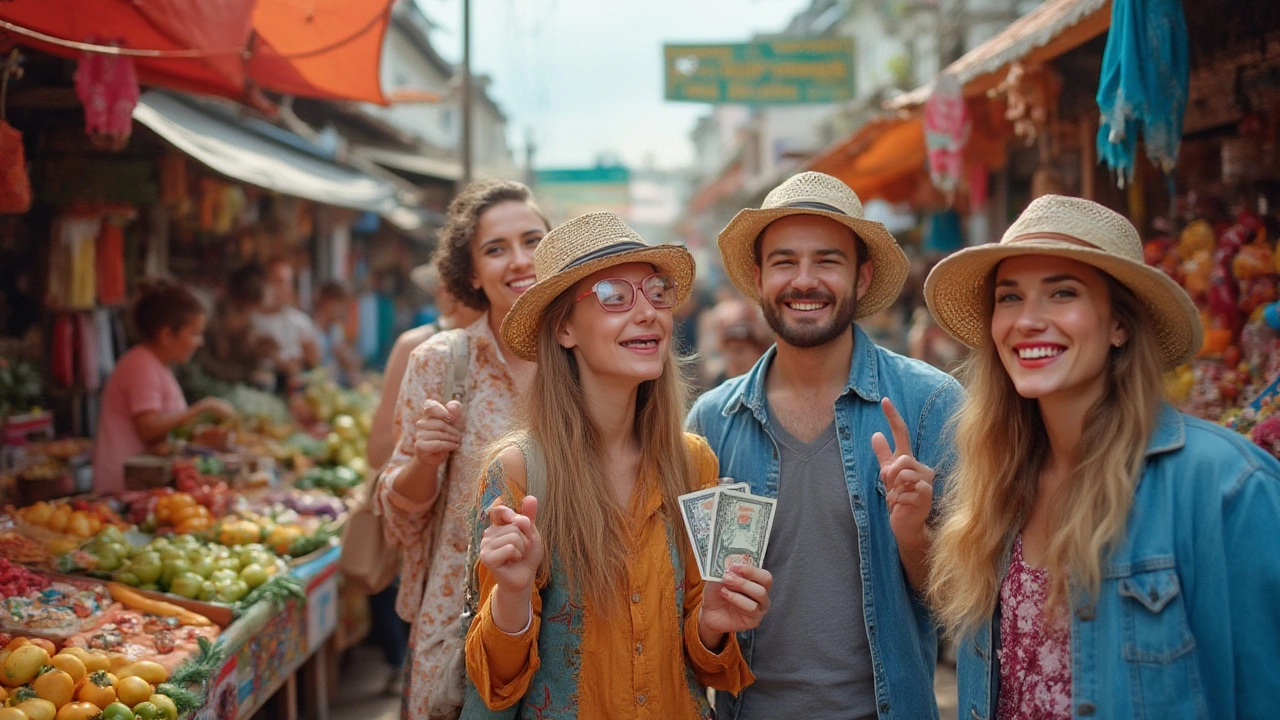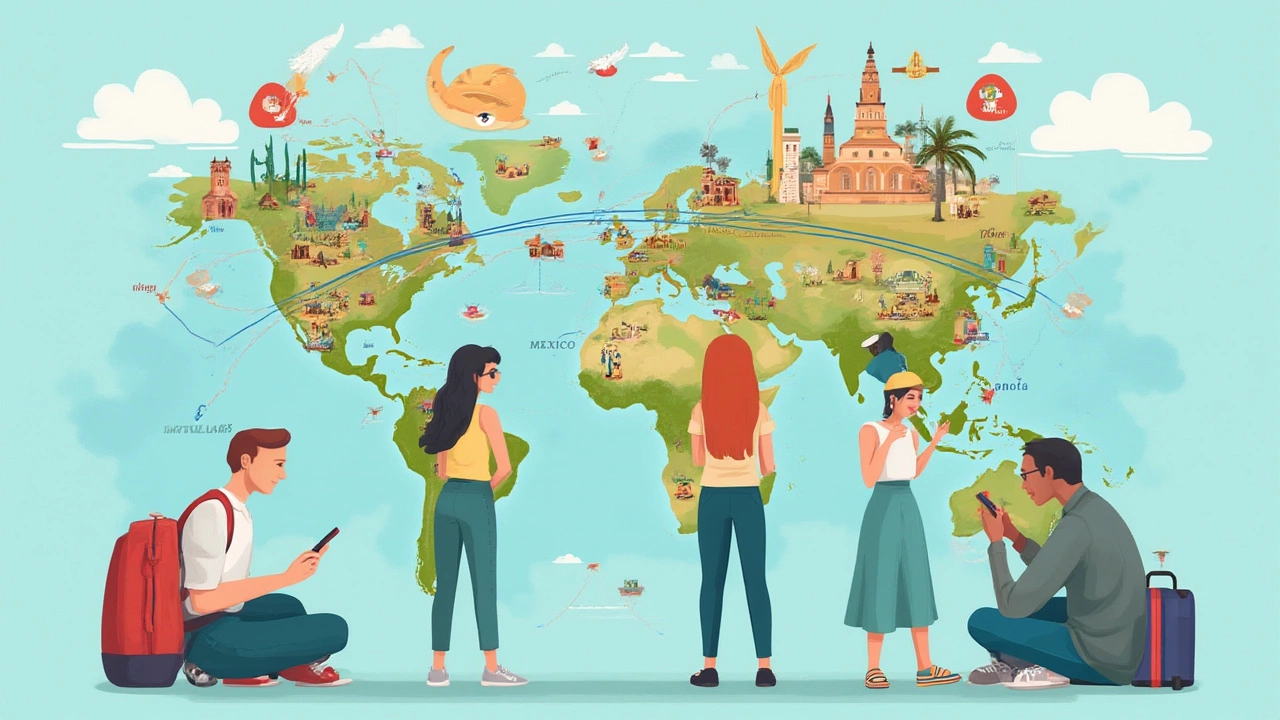Where the US Dollar Goes Furthest: Best Destinations for American Travelers
 Jul, 26 2025
Jul, 26 2025
Picture this: you’re holding a handful of dollars and about to step off a plane, but this time, your cash feels like magic—it buys you hotel upgrades, fancy dinners you’d never splurge for back home, whole experiences that feel out-of-reach stateside. That’s the sweet spot for travelers: finding those places where your US dollar is supercharged, turning an ordinary trip into something way more memorable. In 2025, as inflation lingers at home and exchange rates shift, finding new ways to stretch your money is more tempting than ever. So where does this magic really happen? Where can you actually do more, eat better, and treat yourself without wrecking your budget? Here’s everything you need to know.
Why the US Dollar Has More Power in Some Countries
It’s all about exchange rates and local costs. When the US dollar is stronger than another country’s currency, every dollar converts into a bigger number on the other side. But that’s only half the story. A fabulous exchange rate doesn’t mean much if everything there still costs a fortune. That’s why you want the double-whammy: a strong dollar and low local prices. This sweet spot drives travelers to places like Southeast Asia, parts of Eastern Europe, and several countries in Latin America.
So how do you know where the bang-for-buck is the best right now? Keep an eye on the US Dollar Index, which measures the buck against a basket of foreign currencies. It’s had a strong run in the past two years, pumped up by US interest rates staying higher than usual, which has convinced investors to hold onto dollars. When this happens, you score better hotel deals, cheaper meals, and more room in your itinerary for extras. Remember, the list shifts—currencies like the Argentine Peso or Turkish Lira can swing drastically overnight. A destination that was cheap a year ago may not be now. Always check updated rates and recent traveller reports before booking.
Take a look at the table below for a quick look at how many local currency units a US dollar buys in July 2025, plus an idea of what things actually cost there:
| Country | Currency (July 2025) | USD = Local Currency | Avg. meal price (USD) |
|---|---|---|---|
| Argentina | Peso (ARS) | 1 USD = 1,420 ARS | $4 |
| Turkey | Lira (TRY) | 1 USD = 38 TRY | $6 |
| Vietnam | Dong (VND) | 1 USD = 25,200 VND | $3 |
| Indonesia | Rupiah (IDR) | 1 USD = 16,650 IDR | $2.5 |
| Mexico | Peso (MXN) | 1 USD = 17.1 MXN | $8 |
| Hungary | Forint (HUF) | 1 USD = 358 HUF | $7 |
The numbers paint a tempting story: a dollar stretched in the right country can buy you a good meal, a night’s stay in a boutique hotel, or even a guided city tour. If you want to see proof, just follow the crowds of backpackers flocking to hostels in Vietnam, digital nomads flooding Mexico City, or retirees discovering the food scene of Istanbul.
Top Destinations Where the Dollar Goes Furthest in 2025
Let’s get specific. If you’re daydreaming of places where you get twice—or even three times—the usual value, here’s where you should set your sights this year.
- Argentina: A turbulent economy means wild currency swings, but for now, Buenos Aires is a playground for budget travelers. You can score $1 steaks, designer coffee for $2, and chic Airbnbs in Palermo Soho at a fraction of what you’d pay in any major US city. Patagonia and Mendoza are far less crowded these days, and guided tours are more affordable than ever.
- Turkey: The Turkish Lira keeps sliding, which sounds bad for locals, but it’s incredible for travelers. Think $20 for a luxury hammam experience or a seafood feast on the Bosphorus for less than a cab ride in New York. Cappadocia’s cave hotels? They’re not just dreamy—they’re budget-friendly too.
- Vietnam: Street food in Hanoi or Hoi An will rarely set you back more than $2 a meal, and sipping egg coffee on a balcony feels indulgently cheap. The beaches of Da Nang, Ha Long Bay cruises, and even higher-end spa treatments fit snugly into a modest budget.
- Indonesia: Bali isn’t just for honeymooners with cash to burn. In 2025, the dollar stretches so much that you can stay in a private villa with a pool for what an average US motel room used to cost. Daily massages, surf lessons, local meals, and airport transfers all come with a price tag you’ll barely notice.
- Hungary: Budapest remains Europe’s top value city, with thermal baths, goulash feasts, and world-class views over the Danube Bridge all offered for a credit card bill that doesn’t induce panic. Thermal bath entry? Under $10. Local wine? Around $5 a bottle in local shops.
- Mexico: Sure, the dollar’s edge isn’t as dramatic as in Argentina, but with close proximity and low-cost flights, it’s a practical win. Taco feasts, Mayan ruins, and boutique hotels in Oaxaca or Guanajuato still deliver a ton of value if you compare them to US equivalents, and you won’t feel like you’re slumming it.
Talking to recent travelers backs this up. In Argentina, digital nomads routinely live well for under $1,000 a month. In Vietnam, expats marvel at how easy it is to live on $700 a month in cities that feel lively and cosmopolitan. Tour operators and hoteliers in Turkey say their bookings have surged from American guests lured by the favorable dollar.

What About Safety, Politics, and Convenience?
Of course, it’s not enough for a trip to be cheap—it’s gotta feel safe, welcoming, and smooth to navigate. Some destinations where the dollar is king might not always be the easiest to get around or the most stable. Take Argentina: the economic crisis occasionally causes protests or disruptions, and you’ll want to keep an eye on news updates about demonstrations (even though tourists are rarely targeted). In Turkey, the geopolitical situation can shift, especially near the Syrian border, but Istanbul and the tourism regions are easier and safer than many expect. In Vietnam, traffic is wild (think: motorcycles everywhere), but crime against tourists stays low and the vibe is welcoming.
Another tip: pay attention to tourist scams and petty crime, like pickpocketing in crowded areas—this happens everywhere, but it’s more common in regions where the economic gap is larger. Avoiding trouble often comes down to using your normal street smarts, not flashing expensive gear, and keeping valuables locked up. If you’re headed to places like Indonesia, check weather patterns and note that internet coverage and infrastructure can vary by island.
Visa rules also play a part. While most Americans can get visas on arrival or travel visa-free for up to 90 days in popular cheap-dollar places, always double-check—policies shift fast, especially in regions dealing with economic or political changes. Health restrictions tied to Covid-19 have calmed down in 2025, but certain countries still want proof of vaccination at entry, so make sure your paperwork’s sorted. Travel insurance is a good friend if your budget trip turns into an unexpected adventure (especially in places with rough roads or less-developed medical care).
How to Take Full Advantage Of Supercharged Dollar Value
Cashing in on a strong dollar isn’t just about picking the right country—it’s also about your mindset and planning. Timing matters: exchange rates fluctuate. Use currency-tracking apps before you book flights or hotels, so you lock in at the right moment. Often, things get even cheaper if you pay in local cash instead of using your card (since banks tend to give worse rates). But watch out: always withdraw cash inside bank ATMs, not on the street, to dodge card skimmers. Many seasoned travelers carry two cards—one for cash withdrawals, another for purchases—just in case.
Prices can also differ by season. Travel shoulder seasons in places like Vietnam (late spring or early autumn) or Turkey (May or late September) and you’ll find lighter tourist crowds and even lower costs for everything from hotels to tours. Booking longer stays—think a month rather than a week—unlocks discounts everywhere from apartments in Buenos Aires to beachfront bungalows in Bali. And don’t just hang out with tourists; go local. Neighborhood restaurants (where menus aren’t in English) always give you better value, and local markets let you pick up meals or souvenirs for a steal.
If you’re after a truly local experience, consider using ride-sharing apps or public transport over taxis, which often overcharge tourists anywhere in the world. In Argentina or Mexico, long-distance buses are both comfortable and a fraction of the price of trains or flights. For places with language barriers, translation apps can help you order, haggle, and find your way around without embarrassment—most places are happy you tried.
- Research currency trends and news before booking.
- Use cash for small purchases—local shops give better deals than big tourist spots.
- Check official tourism websites for updated entry requirements and safety tips.
- Book accommodation directly with the property for possible extra discounts.
- Blend in—dress like a local, avoid fancy jewelry or gear, and you’ll dodge both scams and overpricing.

Common Mistakes to Dodge and Insider Secrets
First, don’t assume cheapest means best. Sometimes, the price drop points to bad infrastructure, or safety issues. Always check recent reviews—sites like Reddit’s r/travel or Nomad List are goldmines for current, boots-on-the-ground advice. Try not to show up during public holidays or election seasons, either; prices jump, places fill up, and strikes or political unrest are more common.
Another trap: exchanging money at the airport or hotels. The rates are horrible. Use a bank ATM in the city, or bring a debit card with no foreign fees. Sometimes, official exchange rates aren’t the full story: in Argentina, for example, there’s a “blue dollar” rate on the street that’s much more favorable, but exchanging there comes with risks. For peace of mind, stick to official but favorable channels—Western Union is huge with Americans in Argentina for this very reason, often giving rates close to the street value without the risk.
Be cautious with tours that promise “all-inclusive experiences” at dirt-cheap prices; sometimes these cut corners on safety, especially with activities like trekking, snorkeling, or riding mopeds. Always double-check the operator’s license where possible, or join tours with a few solid, recent reviews from fellow Americans or Europeans.
If you’re renting a car or scooter for local exploring, remember local driving habits can be wild. In Bali or Vietnam, most travelers swear by hiring local drivers rather than going solo.
- Never hand over your passport as collateral for tours or rentals—keep a copy instead.
- Set up banking alerts and call your bank before you leave
- Review your credit card’s travel protections and cancel lost cards quickly.
- Always check food hygiene—busy local eateries = safer bets.
- Double check bills and receipts—rounding up for tourists is common in some countries.
So, is it possible to see the world without breaking the bank? With the right timing and a little research, absolutely. The US dollar in 2025 still holds more power than most Americans realize—just be smart, be flexible, and keep following the deals to places where that little green bill still opens doors to big adventures.
